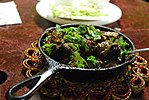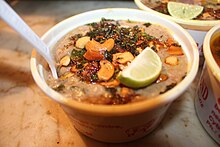Mughlai cuisine
 |
| This article is part of the series |
| Indian cuisine |
|---|
Regional cuisines
|
Ingredients, types of food
|
Preparation, cooking
|
See also
|
Related cuisines
|
|
 |
| This article is part of the series |
Pakistani cuisine پاکستانی پکوان |
|---|
Regional cuisines
|
Ingredients
|
Preparation and cooking
|
See also
|
|
Mughlai cuisine consists of dishes developed in Medieval India at the centres of the Mughal Empire. It represents a combination of South Asian cuisine with the cooking styles and recipes of Central Asian cuisine. Mughlai cuisine is strongly influenced by the cuisine of Central Asia, the region where the early Turko-Mongol Mughal emperors originally hailed from, and it has in turn strongly influenced the regional cuisines of modern Northern India, Pakistan and Bangladesh.[1]
The tastes of Mughlai cuisine vary from extremely mild to spicy, and are often associated with a distinctive aroma and the taste of ground and whole spices.[2] A Mughlai course is an elaborate buffet of main course dishes with a variety of accompaniments.[3]
Contents
1 History of Mughlai Cuisine
2 List of Mughlai dishes
3 Desserts
4 See also
5 References
6 Further reading
7 External links
History of Mughlai Cuisine
Although the ruling class and administrative elite of the Mughal Empire could variously identify themselves as Turani (Turkic), Irani (Persian), Shaikhzada (Indian Muslim) and Hindu Rajput, the empire itself was Indo-Persian, having a hybridized, pluralistic Persianate culture. Decorated Indo-Persian cookbooks and culinary manuscripts adorned the personal libraries of the Mughal elite, serving as both culinary guides and for aesthetic value.[4]
One example was the Ni'matnama, a 15th century work illustrated with Persian miniatures. This was commissioned by Sultan Ghiyas Shah, a sultan of Malwa in modern-day Madhya Pradesh, and features Central Asian dishes such as samosas (fried meat-filled pastry), khichri (rice and lentils), pilaf (rice-dish), sikh (skewered meat and fish), kabab (skewered, roasted meat) and yakhni (meat broth), as well as western and southern Indian dishes, such as karhi (yogurt broth mixed with chickpea flour), piccha and khandawi.
From the Mughal period itself, one popular culinary work was the Nuskha-i-Shahjahani, a record of the dishes believed to be prepared for the court of Emperor Shahjahan (r.1627-1658). This Persian manuscript features ten chapters, on nānhā (breads), āsh-hā (pottages), qalīyas and dopiyāzas (dressed meat dishes), bhartas, zerbiryāns (a kind of layered rice-based dish), pulāʾo, kabābs, harīsas (savoury porridge), shishrangas and ḵẖāgīnas (omelette), and khichṛī; the final chapter involves murabbā (jams), achār (pickles), pūrī (fried bread), shīrīnī (sweets), ḥalwā (warm pudding), and basic recipes for the preparation of yoghurt, panīr (Indian curd cheese) and the coloring of butter and dough.[5]
Another famous textbook was Ḵẖulāṣat-i Mākūlāt u Mashrūbāt, perhaps dating to the era of the emperor Aurangzeb (r. 1656-1707), while another was Alwān-i Niʿmat, a work dedicated solely to sweetmeats. Divya Narayanan writes:
These include varieties of sweet breads such as nān ḵẖatā̤ʾī (crisp bread, like a biscuit), sweet pūrīs, sweet samosas (or saṃbosas), laḍḍū and ḥalwā. The cookbook introduces each recipe with a line of praise: for instance saṃbosa-i yak tuhī dam dāda (samosa with a pocket cooked on dam) is declared as being ‘among the famous and well-known sweets; pūrī dam dāda bādāmī (almond pūrīs cooked on dam) is said to be ‘among the delicious and excellent sweetmeats, and nān ḵẖatā̤ʾī bādāmī (almond nān ḵẖatā̤ʾī) is noted for being ‘among the rare and delicious recipes.[6]
There are even many commonalities between Indo-Persian cookbooks used at the Mughal court and contemporary culinary works from Safavid Iran, such as the Kārnāma dar bāb-i T̤abāḵẖī wa ṣanʿat-i ān (Manual on Dishes and their Preparation) of Ḥājī Muḥammad ʿAlī Bāwarchī Bag̱ẖdādī.
List of Mughlai dishes

Haleem
Dishes include:
Haleem (Khichda)- Tikkas
Biryani

Biryani
- Mughlai Paratha
- Qeema Matar
- Murg Kababs Mughlai
- Murgh Musallam
- Pasanda
- Rezala
Desserts

Kulfi
- Falooda
- Gulab Jamun
- Jalebi
Kesari Firni is a rice based sweet dish streaked with Saffron
Shahi Tukra is a rich bread pudding with dry fruits, flavoured with cardamom.- Sheer korma
See also
- Karachi cuisine
References
^ Mukherjee, Soma (2001). Royal Mughal Ladies and Their Contributions. Gyan Books. pp. 10–. ISBN 978-81-212-0760-7..mw-parser-output cite.citation{font-style:inherit}.mw-parser-output .citation q{quotes:"""""""'""'"}.mw-parser-output .citation .cs1-lock-free a{background:url("//upload.wikimedia.org/wikipedia/commons/thumb/6/65/Lock-green.svg/9px-Lock-green.svg.png")no-repeat;background-position:right .1em center}.mw-parser-output .citation .cs1-lock-limited a,.mw-parser-output .citation .cs1-lock-registration a{background:url("//upload.wikimedia.org/wikipedia/commons/thumb/d/d6/Lock-gray-alt-2.svg/9px-Lock-gray-alt-2.svg.png")no-repeat;background-position:right .1em center}.mw-parser-output .citation .cs1-lock-subscription a{background:url("//upload.wikimedia.org/wikipedia/commons/thumb/a/aa/Lock-red-alt-2.svg/9px-Lock-red-alt-2.svg.png")no-repeat;background-position:right .1em center}.mw-parser-output .cs1-subscription,.mw-parser-output .cs1-registration{color:#555}.mw-parser-output .cs1-subscription span,.mw-parser-output .cs1-registration span{border-bottom:1px dotted;cursor:help}.mw-parser-output .cs1-ws-icon a{background:url("//upload.wikimedia.org/wikipedia/commons/thumb/4/4c/Wikisource-logo.svg/12px-Wikisource-logo.svg.png")no-repeat;background-position:right .1em center}.mw-parser-output code.cs1-code{color:inherit;background:inherit;border:inherit;padding:inherit}.mw-parser-output .cs1-hidden-error{display:none;font-size:100%}.mw-parser-output .cs1-visible-error{font-size:100%}.mw-parser-output .cs1-maint{display:none;color:#33aa33;margin-left:0.3em}.mw-parser-output .cs1-subscription,.mw-parser-output .cs1-registration,.mw-parser-output .cs1-format{font-size:95%}.mw-parser-output .cs1-kern-left,.mw-parser-output .cs1-kern-wl-left{padding-left:0.2em}.mw-parser-output .cs1-kern-right,.mw-parser-output .cs1-kern-wl-right{padding-right:0.2em}
^ [1][dead link]
^ Sahuliyar, Arti (5 July 2008). "Mughlai cuisine tops popularity charts in capital". The Telegraph. Calcutta.
^ Narayanan, Divya (January 2016). "What Was Mughal Cuisine? : Defining and Analysing a Culinary Culture". Interdisziplinäre Zeitschrift für Südasienforschung. 1: 1–30. Retrieved 2019-01-17.
^ "Table Talk: The emperor's new iftar". gulfnews.com. Retrieved 2019-01-17.
^ "Readings in a Culinary Culture", Accounting for Taste, University of Chicago Press, 2004, pp. 83–110, doi:10.7208/chicago/9780226243276.003.0004, ISBN 9780226243245
Further reading
Mughlai Cook Book, Diamond Pocket Books,
ISBN 81-7182-547-8 [2]
Nita Mehta's Vegetarian Mughlai Khaana By Nita Mehta, Published 1999
ISBN 81-86004-10-6
Mughlai By Amrita Patel Published 2004, Sterling Publishers, 160 pages
ISBN 81-207-2646-4
External links
- Mughlai Recipes
- Mughal Emperors' Food
